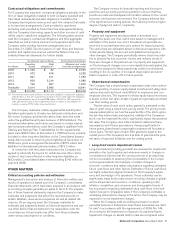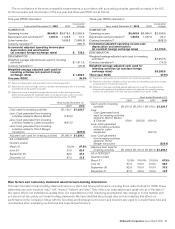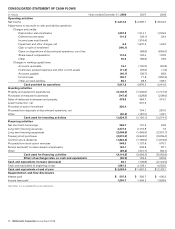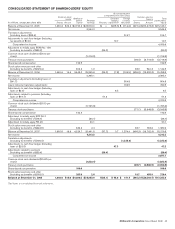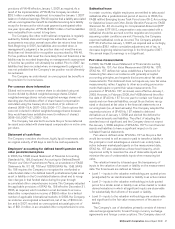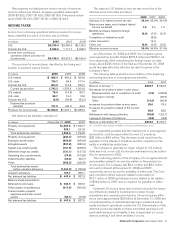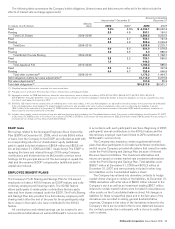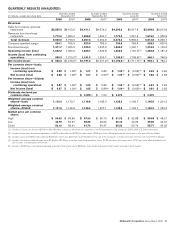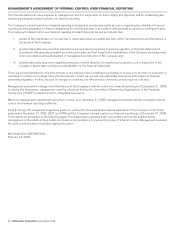McDonalds 2008 Annual Report Download - page 49
Download and view the complete annual report
Please find page 49 of the 2008 McDonalds annual report below. You can navigate through the pages in the report by either clicking on the pages listed below, or by using the keyword search tool below to find specific information within the annual report.provisions of FIN 48 effective January 1, 2007, as required. As a
result of the implementation of FIN 48, the Company recorded a
$20.1 million cumulative adjustment to increase the January 1, 2007
balance of retained earnings. FIN 48 requires that a liability associated
with an unrecognized tax benefit be classified as a long-term liability
except for the amount for which cash payment is anticipated within
one year. Upon adoption of FIN 48, $338.7 million of net tax liabilities
were reclassified from current to long-term.
The Company, like other multi-national companies, is regularly
audited by federal, state and foreign tax authorities, and tax
assessments may arise several years after tax returns have been
filed. Beginning in 2007, tax liabilities are recorded when, in
management’s judgment, a tax position does not meet the more
likely than not threshold for recognition as prescribed by FIN 48.
For tax positions that meet the more likely than not threshold, a tax
liability may be recorded depending on management’s assessment
of how the tax position will ultimately be settled. Prior to 2007, tax
liabilities had been recorded when, in management’s judgment, it
was not probable that the Company’s tax position would ultimately
be sustained.
The Company records interest on unrecognized tax benefits in
the provision for income taxes.
Per common share information
Diluted net income per common share is calculated using net
income divided by diluted weighted-average shares. Diluted
weighted-average shares include weighted-average shares out-
standing plus the dilutive effect of share-based compensation
calculated using the treasury stock method, of (in millions of
shares): 2008–19.4; 2007–23.5; 2006–17.7. Stock options that
were not included in diluted weighted-average shares because
they would have been antidilutive were (in millions of shares):
2008–0.6; 2007–0.7; 2006–16.4.
The Company has elected to exclude the pro forma deferred
tax asset associated with share-based compensation in net income
per share.
Statement of cash flows
The Company considers short-term, highly liquid investments with
an original maturity of 90 days or less to be cash equivalents.
Employers’ accounting for defined benefit pension and
other postretirement plans
In 2006, the FASB issued Statement of Financial Accounting
Standards No. 158, Employers’ Accounting for Defined Benefit
Pension and Other Postretirement Plans, an amendment of FASB
Statements No. 87, 88, 106 and 132(R) (SFAS No. 158). SFAS
No. 158 requires the Company to recognize the overfunded or
underfunded status of a defined benefit postretirement plan as an
asset or liability on the Consolidated balance sheet and to recog-
nize changes in that funded status during the year through
accumulated other comprehensive income. The Company adopted
the applicable provisions of SFAS No. 158 effective December 31,
2006, as required, which resulted in a net decrease to accumu-
lated other comprehensive income of $89.0 million for a limited
number of applicable international markets. In 2008, the Company
recorded an unrecognized actuarial loss, net of tax, of $60.4 mil-
lion and in 2007 recorded an unrecognized actuarial gain, net of
tax, of $51.3 million, in accumulated other comprehensive income.
Sabbatical leave
In certain countries, eligible employees are entitled to take a paid
sabbatical after a predetermined period of service. In 2006, the
FASB ratified Emerging Issues Task Force Issue 06-2, Accounting
for Sabbatical Leave and Other Similar Benefits Pursuant to FASB
Statement No. 43, Accounting for Compensated Absences (EITF
06-2). Under EITF 06-2, compensation costs associated with a
sabbatical should be accrued over the requisite service period,
assuming certain conditions are met. Previously, the Company
expensed sabbatical costs as incurred. The Company adopted
EITF 06-2 effective January 1, 2007, as required and accordingly,
recorded a $36.1 million cumulative adjustment, net of tax, to
decrease beginning retained earnings in the first quarter 2007.
The annual impact to earnings is not significant.
Fair value measurements
In 2006, the FASB issued Statement of Financial Accounting
Standards No. 157, Fair Value Measurements (SFAS No. 157).
SFAS No. 157 defines fair value, establishes a framework for
measuring fair value in accordance with generally accepted
accounting principles, and expands disclosures about fair value
measurements. This statement does not require any new fair value
measurements; rather, it applies to other accounting pronounce-
ments that require or permit fair value measurements. The
provisions of SFAS No. 157, as issued, were effective January 1,
2008. However, in February 2008, the FASB deferred the effec-
tive date of SFAS No. 157 for one year for certain non-financial
assets and non-financial liabilities, except those that are recog-
nized or disclosed at fair value in the financial statements on a
recurring basis (i.e., at least annually). The Company adopted the
required provisions of SFAS No. 157 related to debt and
derivatives as of January 1, 2008 and elected the deferral for
non-financial assets and liabilities. The effect of adopting this
standard was not significant, and the Company does not expect
the January 1, 2009 adoption of SFAS No. 157 for non-financial
assets and liabilities to have a significant impact on its con-
solidated financial statements.
Fair value is defined under SFAS No. 157 as the price that
would be received to sell an asset or paid to transfer a liability in
the principal or most advantageous market in an orderly trans-
action between market participants on the measurement date.
SFAS No. 157 also establishes a three-level hierarchy, which
requires an entity to maximize the use of observable inputs and
minimize the use of unobservable inputs when measuring fair
value.
The valuation hierarchy is based upon the transparency of
inputs to the valuation of an asset or liability on the measurement
date. The three levels are defined as follows:
• Level 1 – inputs to the valuation methodology are quoted prices
(unadjusted) for an identical asset or liability in an active market.
• Level 2 – inputs to the valuation methodology include quoted
prices for a similar asset or liability in an active market or model-
derived valuations in which all significant inputs are observable
for substantially the full term of the asset or liability.
• Level 3 – inputs to the valuation methodology are unobservable
and significant to the fair value measurement of the asset or
liability.
The Company’s use of derivatives primarily consists of interest
rate exchange agreements, forward foreign currency exchange
agreements and foreign currency options. The Company does not
McDonald’s Corporation Annual Report 2008 47


